This is a guest article by Jérôme Luraghi from WeDploy
The tourism industry is one of the most digitized sectors. It has constantly reinvented itself to offer an experience that is ever richer and more immersive throughout the customer journey. Technology is seen as an ally and an undeniable lever for growth for companies that use it wisely. It is ever-changing, evolves more quickly, and profoundly transforms organizations from distribution to commercialization, including customer relationship management.
Technology permits you to do everything
In this race to be competitive, hoteliers have several options for equipping themselves:
- Developing an in-house solution;
- Acquiring an existing one (e.g., Accor bought FastBooking and Availpro);
- Implementing a third-party solution from a generalist editor (e.g., Oracle, Infor, Zucchetti, Septeo), or a specialist in the sector with a single product (E.g., Mews, Duetto, Duve, Backyou);
- Deploying an offering that includes a set of application solutions (E.g., Sabre, Planet, Cendyn, Shiji); or
- Co-developing with a technological partner (E.g., IHG & Marriott with Amadeus, Adagio with Infor [formerly EasyRMS].
Some hotel chains have considered going the way of internalization. This concerns not only the central operational solutions of the hotel ecosystem, such as a PMS (Property Management System), but also satellite solutions, such as an RMS (Revenue Management System) or CRM (Customer Relationship Management). The reasons for opting for a custom solution are tempting and numerous.
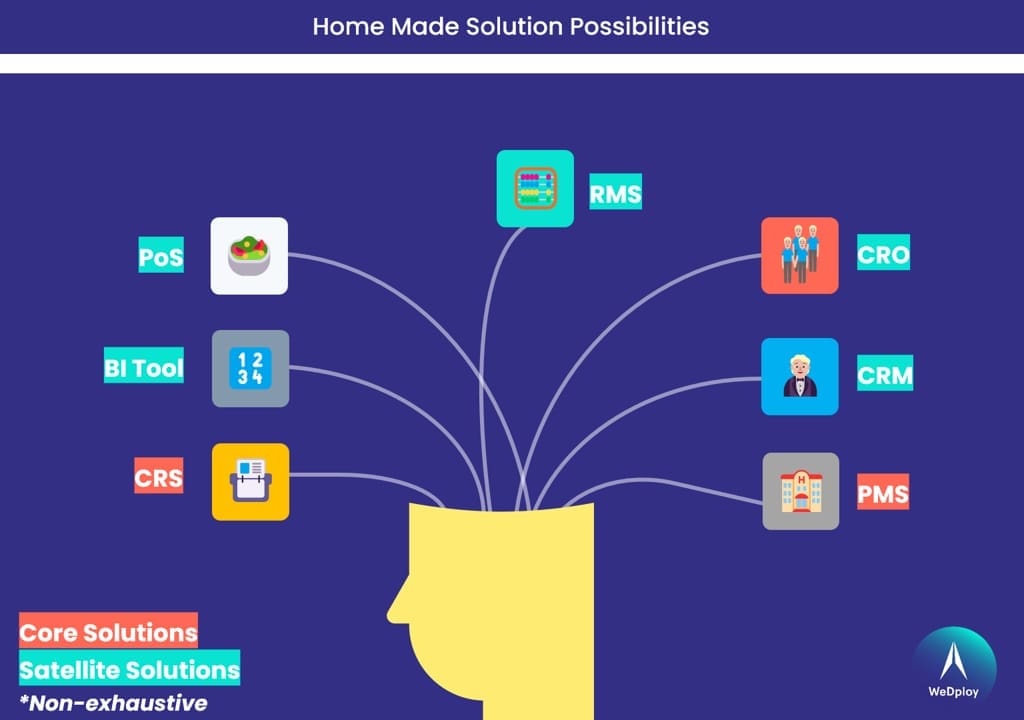
Core and satellite solutions for hotels
But there's a global question: Is it the role of hoteliers to build their own tools? From different perspectives, the hotel industry is often compared to the airline industry. In this highly regulated and complex field, operators rely heavily on the expertise of technological actors. The landscape is thus less fragmented and more standardized.
When it comes to business intelligence, we have created our own BI so revenue managers always have all the numbers to take decision. [...] We also partner with third-parties for food & beverages, meeting & events, to cover other revenue streams.
Technological Evolution in Hospitality: A Brief History
Before the hospitality industry went digital, some of us remember (those who do!) the Yellow Pages casually lying next to the landline.
Reservations? They arrived via mail or telephone call. Check-ins and check-outs were recorded in large manual registers. Efficient? Yes, in its own way, but not without the risk of double bookings or forgetfulness.
The Advent of Computerized Reservation Systems (1970-1990)
The rise of technology in the 1970s led to a revolution in the travel and hospitality world. Computerized reservation systems, or GDSs (Global Distribution Systems), transformed reservation management and enabled establishments to market themselves globally. Here's a brief overview of the deployment timeline of major GDS:
- Sabre: Born in 1960, it thrived in the 1970s, connecting airlines and hotel inventories in real-time, improving bookings.
- Amadeus: Established in 1987, this Spanish giant has become a major player in technological solutions for travel.
- Galileo: Originally Travicom in 1971, it became Galileo in 1987, linking travel agencies and providers. In 2007, after merging with Worldspan, it transformed into Travelport.
In hospitality, these systems provided a platform for establishments to reach a global audience, far beyond their traditional marketing strategies. Integrating hotels into these GDSs not only increased their visibility but also standardized the booking process, making the experience smoother for end customers.
However, alongside these benefits, it also introduced a new level of complexity for hotels: setting up and managing rates. As Robert G. Cross pointed out in his chapter on American Airlines (Revenue Management Hard-Core Tactics for Market Domination, 1997), this was the advent of professions related to distribution and pricing.
The Modern Era (from 1990 to the present)
The Early Days of the Public Internet (1990 - 2000):
- Emergence of the first hotel websites: Some establishments quickly grasped the importance of having an online presence.
- The start of RMSs: At that time, RMSs were primarily focused on historical data analysis.
The Rise of OTAs and Mobility (2000 - 2010)
- Online booking portals and OTAs (Online Travel Agencies): Major players like Booking.com or Expedia (launched as soon as 1996) began to take up a lot more space in the market. Airbnb (2008) also started the online booking revolution for leisure travelers.
- Evolution of RMSs: With increased competition and new distribution channels, RMS had to adapt and integrate more data sources.
The Democratization of SaaS and Artificial Intelligence (since 2010)
- Mobile technologies: Bookings increased via smartphones and tablets.
- Advanced RMS: AI (Artificial Intelligence) and Big Data enabled real-time predictive analytics, dynamic pricing, and increased customization.
The democratization of digital solutions enabled by the SaaS (Software As A Service) model has seen the emergence of a plethora of actors and providers constantly competing to provide more innovative and high-performing technological solutions.
Solutions are becoming increasingly open, facilitated by the implementation of APIs, the standardization of a common language, and the continuous work over the past few years of the HTNG (Hospitality Technology Next Generation) association, which brings together stakeholders: hoteliers and technological partners. Changing solutions has never been so simple from a purely technical standpoint (which does not mean that the integrations are perfect), with a vision of plug and play made possible by marketplaces (Planet Marketplace, Oracle's OHIP).

A brief history of hotel booking and revenue management systems
It can be observed more broadly that the rise of SaaS products has completely reshuffled the deck. Furthermore, the Covid pandemic provided hotel groups with a pause in which to rethink themselves. Historically, economic downturns have been opportune times for technological investments, allowing companies to emerge more competitive. Investments in quantum computing are expected to open up other possibilities and many challenges.
Tools must support staff to gain in productivity and efficiency
Drivers and Benefits of In-House Solutions
In an industry where every detail counts and the competition is fierce, differentiation has become an absolute necessity for hospitality. The most reliable way? Providing an exceptional customer experience.
Desire for Customization: Offering a Unique Customer Experience
With internally developed technological solutions, hotel establishments can thus shape their tools in the image of what they want to convey: their identity, their customers, their values.
Take, for instance, the "Connecting Rooms" that Hilton guarantees, an innovation that, although it may seem trivial, can make all the difference for families or groups needing to travel and stay together.
But this need for customization doesn't stop there. Each hotel chain or establishment has its own peculiarities: its staff, its network, its clientele, its investors, its skills, and its methods. And it is from this perspective that the customization of technological tools comes into play. Indeed, offering unique tools carries immense weight during discussions with potential franchisees.
To illustrate this, let's consider two examples: the PMS of Choice Hotels and the RM Pulse solution of Radisson Hotels Group. These platforms, designed specifically to meet the needs of these chains, are leading the way in terms of customized technological solutions, emphasizing the importance of customization in the current hotel landscape.


Guaranteed connecting rooms by Hilton
Guaranteed connecting rooms by Hilton. Here, the focus is on the experience by targeting a specific clientele: the family segment. Offering the possibility to directly book two connecting rooms online is a technological challenge but also a mini revolution for booking engines.
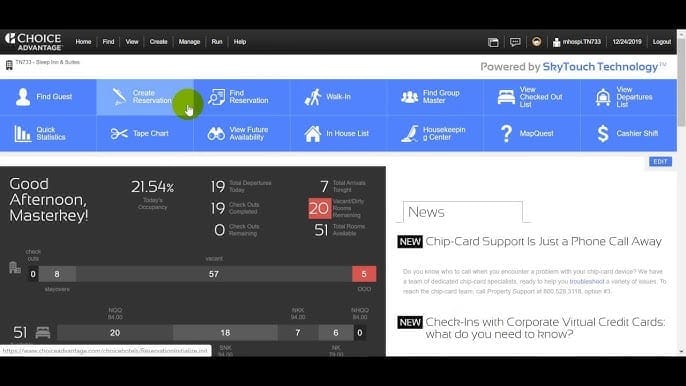
choiceADVANTAGE dashboard
choiceADVANTAGE, the web-based PMS of Choice. The idea is to convince investors the technology is the best on the market. Unique to the Choice ecosystem, the advantages of this PMS could be articulated around inventory distribution, the CRM aspect, and a user-friendly interface.
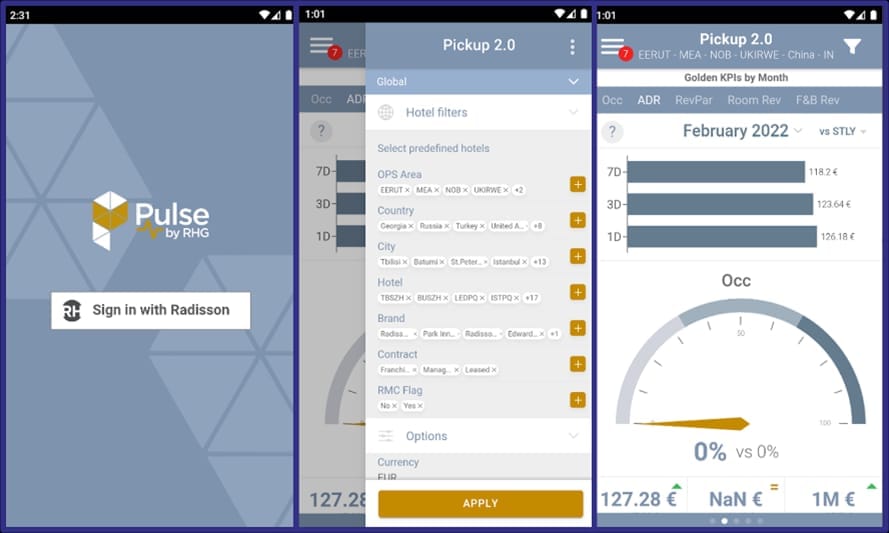
Pulse mobile interface
Pulse is the Revenue Management solution promoted for Radisson group hotels. An internal cloud application launched in 2019, it combines internal and external data, allowing for the management of rates and restrictions with just a few clicks.
A hotel group that owns its technology has a major competitive advantage because it is assured that its unique product requirements are met and that there is full control over issues that may develop in the future.
Economic Independence: Reducing Costs
Operators in the tourism sector are constantly looking for ways to optimize their budgets. One of the levers for this is controlling expenses related to the use of SaaS tools, whether subscription costs or commissions. Over an extended period, these expenses, although they may seem minor at the outset, add up quickly. Consider the fees linked to connectivity, which are typically calculated per room annually, or the percentage of revenue from a single booking. Additionally, factor in the implementation fees, and the dependency and lack of control over the increasing costs from the technology partner.
Opting for internal tools generally involves a higher initial cost. However, this expense can be justified over time by eliminating recurring fees. This autonomy also allows hotels to make changes or updates at their discretion, without waiting for a third party's approval. For tooling, there are generally two scenarios depending on the type of project.
Incipient projects. The stakes are relatively low, allowing for internal advancement with existing tools. We are in the initial or testing phase, and we seek short-term efficiency. Ideally, we would be accompanied by a specific solution, but in reality, we usually proceed with an Excel sheet or Google Sheets. Not perfect, but it will cover 80 percent of our needs! For example, we can mention the sales forecasts for the current month, the budget exercise, or the work of a Project Manager on the different phases and steps of a project.
Strategic Projects. In 2015, Accor demonstrated its ambition for economic independence by transforming its distribution platform AccorHotels.com into a marketplace open to a selection of independent hotels. Although the project was abandoned at the end of 2017, the strategy had a dual objective for the group:
- To significantly increase the available hotel offer and
- To reduce distribution costs by taking on OTAs on their own turf.
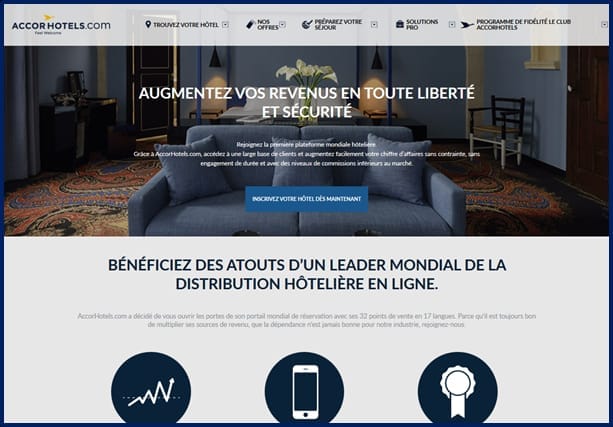
The Marketplace offered by Accor in 2015
Integration and Synergy: In-House Solutions for Better Tool Harmonization
Consistency is the key to operational efficiency. Hotels use a multitude of tools, ranging from reservation systems to CRM and Revenue Management tools. By developing in-house solutions, it is possible to ensure a seamless integration of these tools, guaranteeing that all systems communicate effectively with each other, minimizing errors, and maximizing efficiency.
Since its inception, Airbnb has been a technology-driven company. The platform was designed to connect hosts with available space to travelers looking for unique accommodations. With the company's rapid growth, the need to integrate multiple tools and services became clear.
Airbnb has developed several in-house tools and solutions to improve the efficiency of its operations and user satisfaction. For example, to help hosts determine the right price for their listings, Airbnb created a dynamic pricing algorithm. This tool, developed internally, analyzes numerous factors such as local demand, nearby events, and prices of similar listings to suggest an optimal price to hosts.
Moreover, Airbnb launched its own payment system. Instead of relying on third-party providers, the company developed a solution tailored to its specific needs. This allowed them to tightly integrate payments with other aspects of the platform, improve user experience, and reduce costs.
Finally, the platform also integrated a messaging system, again in-house, to facilitate communication between hosts and travelers. Instead of using external messaging services, this in-house solution ensures that all communications are centralized, secured, and easily accessible.
By choosing to develop these tools internally, the American company not only strengthened its position as a technology leader in the travel industry but also created synergy between its various services, thus offering a seamless and integrated user experience.
Operational Reactivity: Gaining an Edge Over the Competition
In today's competitive landscape, businesses must be able to quickly adapt to market changes, customer needs, and technological advancements. One of the main benefits of developing technological solutions in-house is the ability to be agile and responsive to make software updates/upgrades.
When a company relies on external providers for its technological solutions, it is often limited by the providers' update cycles, contracts, and adaptation timeframes. On the other hand, with an in-house solution, changes can be made almost immediately, allowing the company to respond quickly to any situation or opportunity that arises.
This is what allowed the CitizenM group to quickly launch in 2020 an offering that brought experience and value to their customers: the corporate subscription.
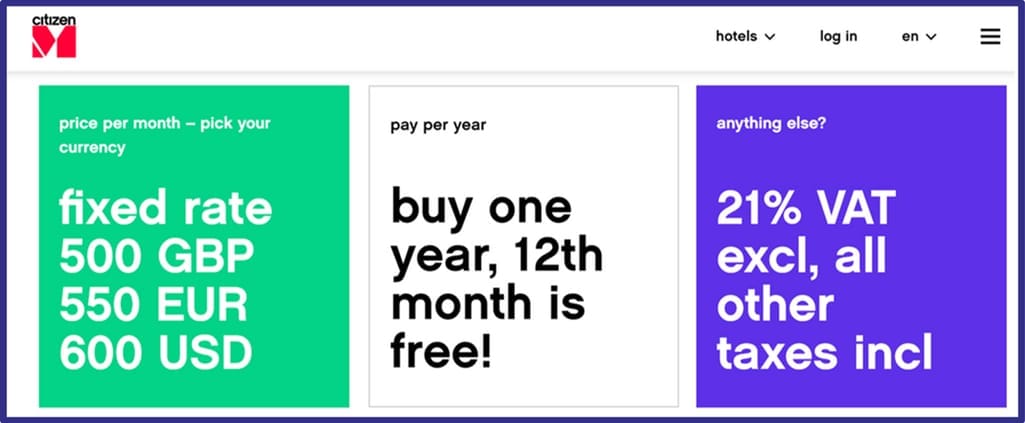
Offer includes access to coworking spaces, 3 BB nights/month available worldwide, and various discounts
This professional subscription was aimed at workers looking for a city base to occasionally escape their apartment, whether for a meeting, a day of work, or a night's sleep.
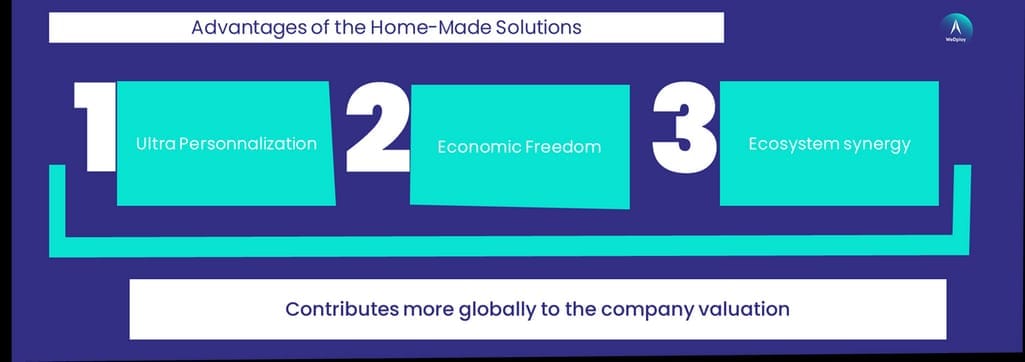
Why you may opt for a custom-made software as a hotelier
As previously mentioned, a hotel group that owns its technology has a major competitive advantage. Aside from controlling its own needs and development, it also keeps its data (e.g., CRM data) on close hold without having to share it on third-party platforms.
When it runs well, the knowledge and expertise combine to generate an advantage over the competition and increase the company value.
The Challenges and Issues of In-House Solutions:
Developing in-house tech solutions is no small feat. It requires solid technical expertise, adequate resources, and ongoing commitment.
Technical Complexity: A Mountain to Climb
Take the example of RMSs, essential for dynamic pricing and revenue optimization, requiring complex algorithms, smooth integration with other systems (such as a PMS or CRS), and continuous updates to reflect market trends.
Creating an internal RMS that can compete with established market solutions is a real challenge, reserved for a few leading players. Some industry players have even co-developed with titans: Hyatt with e.FLEX, or IDeaS delivering either GRO for Hilton's mid-scale segment or ChoiceMax for Choice Hotels.
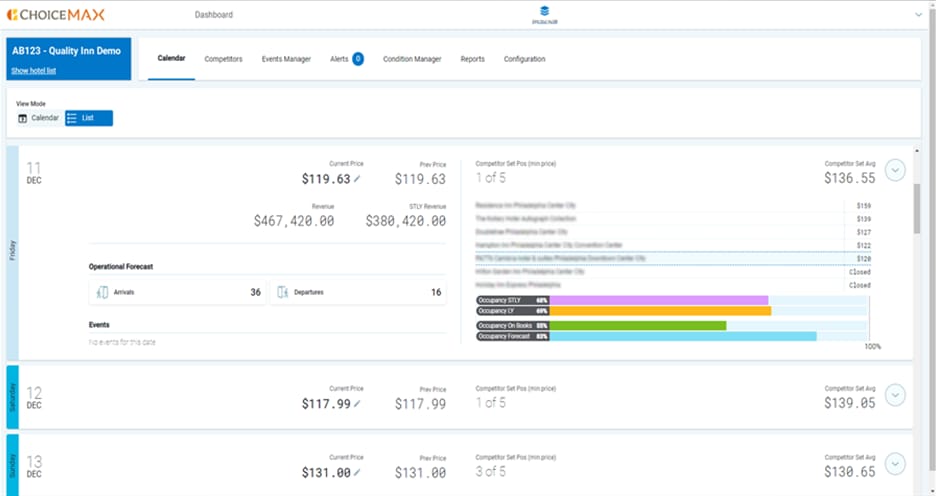
ChoiceMax interface
However, the technical aspect is broader. On the one hand, it includes other challenges such as integrating the tool into the overall ecosystem. On the other hand, translation and multi-language interface maintenance are also key in an international context for user adoption.
Hidden Costs: Time, Training, Maintenance
Beyond the initial development costs, in-house solutions often lead to hidden costs. For example, once a new tool is in place, staff must be trained to use it effectively and retain knowledge internally. Corporate brain drain at the corporate level is one of the trickiest elements to deal with. Maintenance (internal or outsourced) or the evolution of functionalities become more difficult to implement later on.
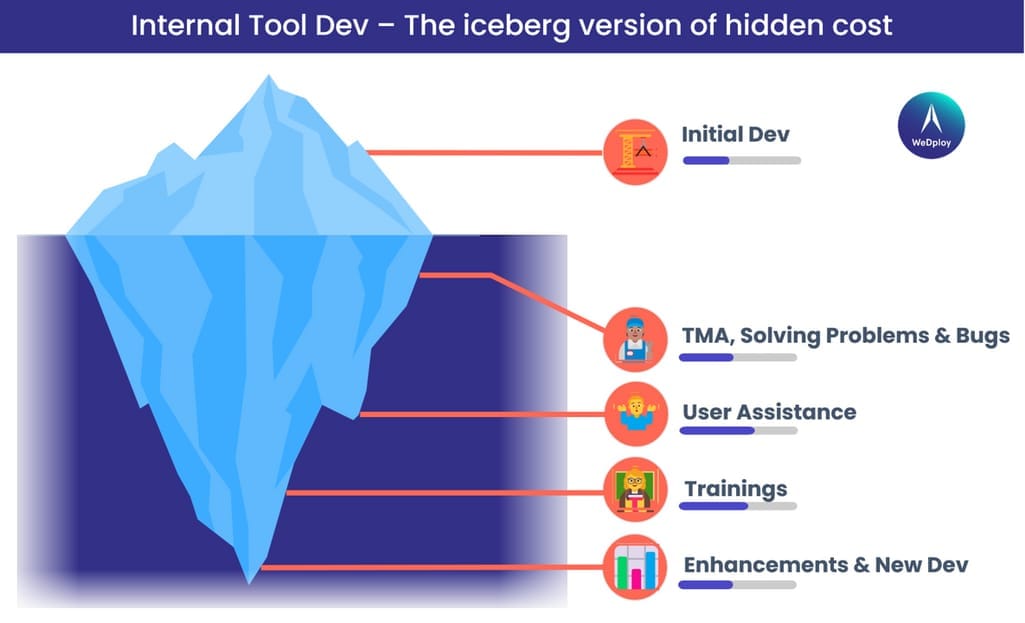
Custom solutions may entail extra costs that aren't evident at the development stage
Scalability: The Challenges of Growth and Evolution
The ability of a solution to scale is essential, especially in an industry as dynamic as hospitality. We all remember the example of that Excel file cobbled together to move quickly. Data extraction, cleaning, and formatting. The test version, or PoC (Proof of Concept), looks attractive, but beware, it often gets complicated when you have multiple data sources, volume, or specific features to add.
This will also be an interesting challenge to follow on the part of Radisson Hotels Group. Gianni di Fede suggested a few weeks ago the possibility of offering the services of The Club, an internal startup in RM, to independent hoteliers. Moving forward in a standardized environment using the same technologies and data sources would obviously be easier. However, connecting to a multitude of solutions with data integration not necessarily established is also a major obstacle to growing one's business.
We have in mind to do a spin-off and take [Pulse RM] to the market potentially one day serving independent hotels.
Security: Ensuring Protection Without the Resources of a Tech Company
Security is a major issue for all systems, not just RMS. Take, for example, an access management system, like electronic keys. These systems are essential to ensure room security but are also potential targets for cyberattacks. If a hacker manages to access this system, the consequences could be disastrous. Sure, all businesses are vulnerable, but relying on specialized external providers who are more often confronted with these issues allows minimizes this risk.
In 2018, Marriott International revealed that its reservation database, which belongs to its Starwood brand, had been the subject of a data breach. This breach, which began in 2014 and was not discovered until 2018, compromised the information of up to 500 million customers. The exposed data included names, addresses, phone numbers, email addresses, passport numbers, Starwood Preferred Guest account information, and in some cases, credit card information.
This breach highlighted the risks associated with data management in the tourism and hospitality sector. It led to considerable criticism of Marriott, particularly regarding its data security management and due diligence during the acquisition of Starwood in 2016.
The Balance: How to Determine if an In-House Solution is the Right Choice?
For good project management, WeDploy believes that three pillars are essential: human resources, time, and financial investment.
Before diving into the development of an in-house tech solution, it is crucial to assess the specific needs of the establishment or hotel chain. This assessment must be holistic, considering operational, financial, and strategic needs.
Moreover, it is vital to evaluate the skills and resources available to the organization. For example, a luxury hotel focused on a highly personalized customer experience might benefit from a custom solution, while an establishment with limited technical resources might be better served by an outsourced and standardized solution.
The financial aspect is also important. Although the initial cost of an off-the-shelf solution may seem high, the hidden costs of an in-house solution (such as maintenance, training, and updates) can accumulate over time. A thorough analysis of short, medium, and long-term costs can help illuminate the decision.
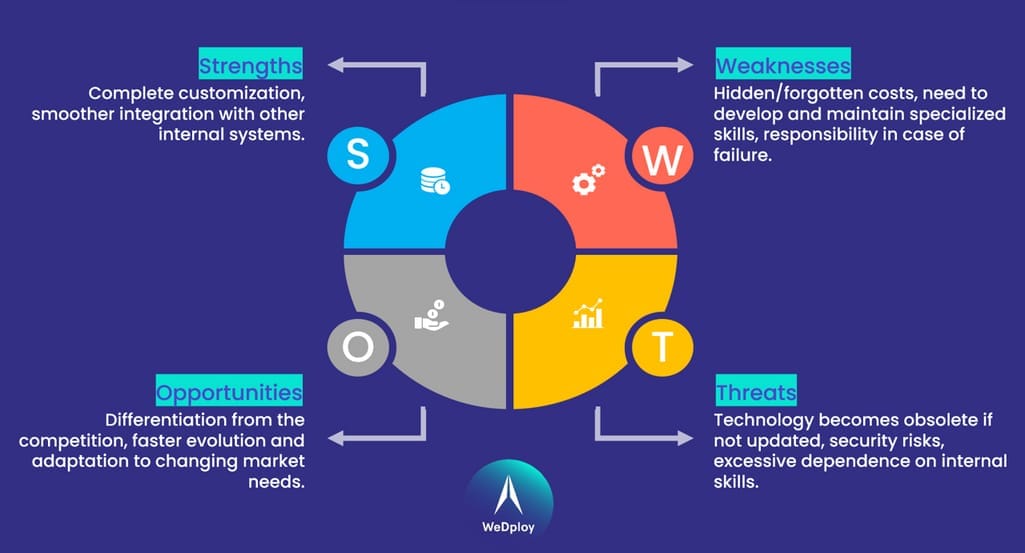
SWOT Analysis of an In-House Solution
Conclusion
Technology plays an undeniable role in how the hotel industry operates today. Against the apparent advantages of in-house solutions, i.e., customization and increased control, stand challenges such as technical complexity, hidden costs, and data security issues.
Therefore, it is imperative that each hotel or hotel chain carefully assess its needs, resources, and ambitions before committing to a particular path. With technology evolving very rapidly: is it reasonable to take on several development cycles when the market launch could potentially make the solution obsolete? The choice of in-house development offers undeniable advantages but also brings a set of responsibilities. On the other hand, entrusting the development and maintenance to third parties can be reassuring and beneficial, offering the support and expertise of a specialized solution provider. This also ensures continuous product updates. IDeaS' parent company (SAS) has committed to investing a billion dollars in research and development within 3 years. Faced with such investments, who can claim to develop in-house tools that are as effective?
There is no universal answer. The important thing is to base the decision on a comprehensive and careful assessment of needs, potential, and risks. Beyond the search for a solution and the optimal integration between two systems is the need for a coherent overall ecosystem that must take precedence. Digital transformation does not happen by chance and requires a strategy!
What tech innovations do you consider the most significant for hotel groups? What obstacles and risks must in-house solutions overcome? Share your experiences and opinions on this topic by leaving us a comment!

Jérôme LURAGHI is a cofounder of WeDploy. With fifteen years of experience in the tourism and hospitality sector, he has not only acquired industry expertise from operators but has also developed in-depth technical skills with technology solution providers. By understanding the organization and internal operations of a provider, Jérôme and WeDploy can assist in selecting and deploying the most suitable solutions for your challenges. Reach out on LinkedIn or on WeDploy Website.
Want to write an article for our blog? Read our requirements and guidelines to become a contributor.

